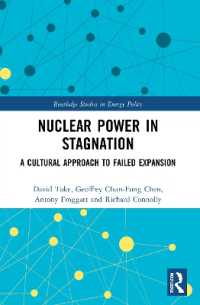- ホーム
- > 洋書
- > 英文書
- > Business / Economics
Full Description
Land concentration has been a central feature of the history of nearly all empires, regions, and countries, and has underpinned the creation of the state and of inegalitarian and elitist societies. It is the key feature of the "monopolization model", whereby a small group attains access to the great bulk of available land, labor, and capital to achieve a high level of income and wealth. The degree and means of land concentration, as well as the elite control of labor, have varied across cultures and time, but are responsible for an enormous amount of economic and social damage.
In The Great Curse, Albert Berry reviews the main episodes of agrarian reform undertaken in the twentieth century to remedy land concentration, including those of major communist and capitalist countries. He provides an understanding of when landholding inequality arises, what implications it has for development in the short and long term, and what potential policies can fix it. Berry makes the case that agrarian reform has resulted in enormous benefits, from the lowering of income inequality and social depravation to a rise in total agricultural output and faster overall growth. Despite the benefits, he finds that most reforms fell far short of their desired outcomes due to conflict and partial or ineffective implementation. In some cases, large communal or state farms were created rather than small private family farms, and in other cases, too little land was redistributed or land was allotted to the wrong groups. Finally, Berry draws on various land reform policies in Sub-Saharan Africa--the only part of the developing world where over half of the labor force is still found in agriculture--with a view to providing useful lessons for its present and future policy in this domain.
Contents
Glossary
Introduction
Section I: The History and Microeconomics of Land Concentration
Chapter 1. Land Concentration: Historical Origins, Socio-Economic Effects, Political Logic, and Surrounding Narratives
Chapter 2. Land Concentration in Early Modern European Development and Its Intellectual Legacy
Chapter 3. Economics and the Welfare Impacts of Farm Size and Tenure
Section II: The Mixed Record of Twentieth Century Attempts at Land Reform
Chapter 4. Assessing the Success of Land Reforms
Chapter 5. Land Reform under Communist Regimes
Chapter 6. Land reform under Capitalist Regimes in 20th Century Latin America: Varying Degrees of Failure
Chapter 7. Twentieth Century Land Reforms in the East Asian Tigers, India, the Middle East and the Philippines: Varying Degrees of Success
Section III. Implications of Past Global History for the Future in Sub-Saharan Africa and Elsewhere
Chapter 8. The Last Battleground for Rural Land Issues: Sub-Saharan Africa
Chapter 9. Agrarian Reform in World History: Success and Failure
Bibliography
Index







